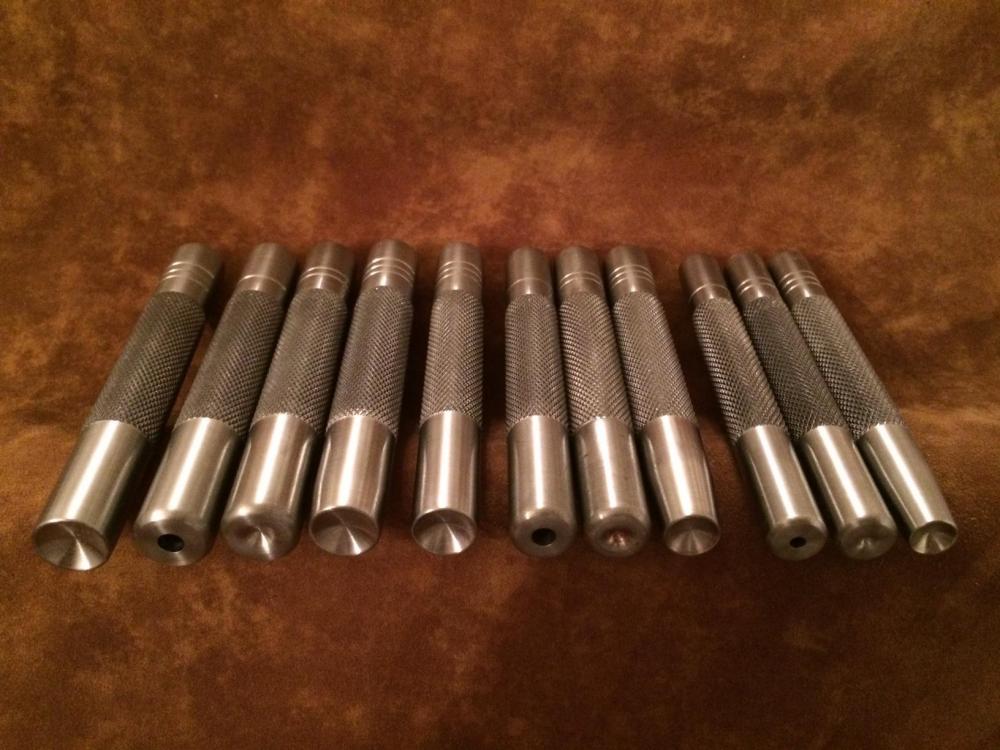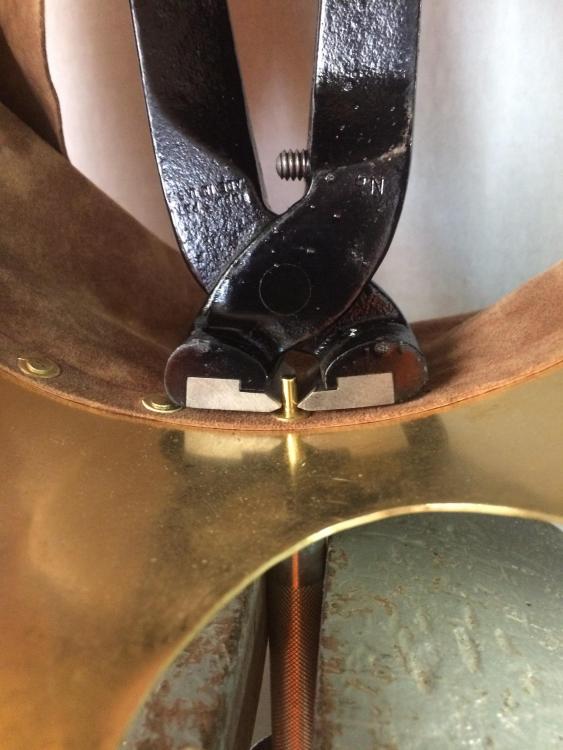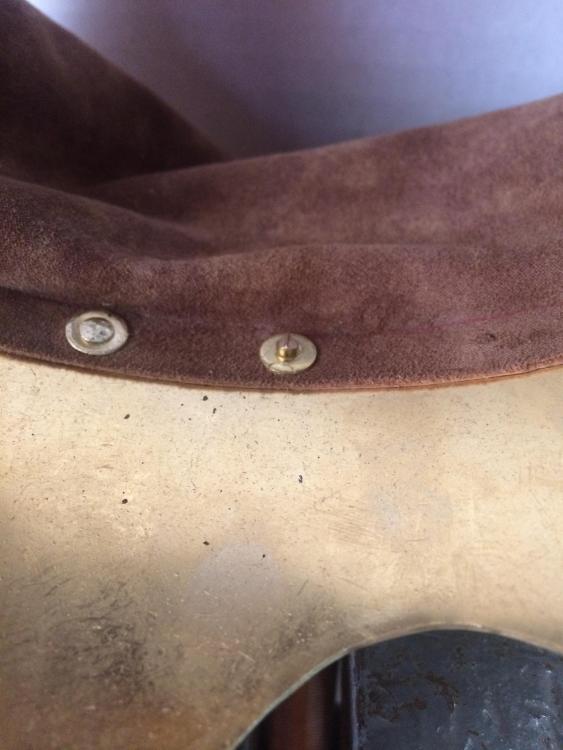-
Posts
259 -
Joined
-
Last visited
Content Type
Profiles
Forums
Events
Blogs
Gallery
Everything posted by 480volt
-
As others have pointed out, an inexpensive punch set from a land far, far away will likely work for you. If you are interested in old, high quality drive or arch punches, Bruce Johnson has some listed on his site, mostly Osborne. Anything you buy from him will be ready to go right out of the box. It will blow right through your budget, though, to try to build a complete set, and the sizes available depends on what he has on hand. Brettun’s Village lists a domestically made set 1/4 - 5/8 by 16ths, for 45 bucks, freight included. These are interchangeable head punches. I’ve been meaning to pick up a set myself for punching things I don’t want to use my good punches on (like gaskets)
-
A few observations: The motor rating plate indicates that it is single-voltage. This is not surprising as the controller voltage range isn’t that great. Dual-voltage three phase motors sold in the US are usually nine-lead, where each winding is divided in half and you connect them either in series (hi voltage) or parallel (low voltage). European motors are more commonly wound so that you can configure them as wye or delta to change the voltage. I have been a commercial/industrial electrician in California for decades and have yet to come across one of these. Somewhere, I have seen a reference from a manufacturer directing the user to add a capacitor to allow a three-phase motor to run on single-phase, however, if the motor is not designed for this it will overheat. Looks like you have to run the style of motor that came with it because of the clutch/brake setup. It would be a long shot, but maybe one of the dealers on this board has a 120V single-phase version of this motor? Then you may only need to boost the voltage to the controller. Is the circuit available dedicated or is it sharing with other machines? Assuming you do get it to work, you will be relying on old electronics that likely need a backup machine to cannibalize for parts if something fails. Just some factors to weigh before you get into it for a lot of money.
-
Looks like there are a lot of features on this machine. Do you know if the electronics check out? The wiring diagram in the link doesn’t give you much to go on, just the pin-outs for the controller. Is there a diagram of the machine overall? First thing I look for is where L1, L2, L3 connect. If the controller can be separated from the motor, I’d do just that, feed the motor from a vfd or rpc and feed the controller from the same circuit feeling the phase converter. But I’m just speculating. The thing may just run fine off the vfd. The person you may want to ask is Gottaknow, he is the head mechanic for a domestic garment manufacturer, and is a wealth of information on some of the more arcane aspects of industrial machines. He visited last about a week ago.
-
The controller may or may not like the square-wave output from the vfd, and you would not be able to use it for speed control. The electronics in three-phase equipment invariably is single-phase with a transformer connected across two legs. Only the motor needs actual three-phase. What does the controller do to make it worth retaining?
-
Is this a three-phase machine you are trying to power off single-phase?
-
I am certainly no expert on Civil War weapons, but the vast majority of long guns used by both sides were rifled, muzzle-loading and fired by percussion cap. There were also rifles and carbines by Spencer and Henry that fired brass (or copper) cased cartridges from a magazine. Given the nature of the conflict, soldiers frequently brought their own weapons, so it is conceivable that some brought great-grandpa’s flintlock to duty, but these were weapons of that “other “ civil war we fought in the late 1770s.
-
I’m sure it’s the same in Australia, but in Northern California, you’ll see clapped out old water trucks parked on ag property, never to be used on the road again, but capable of delivering pressurized water after the power fails. Might at least be able to keep your roof wet or refill your extinguishers.
-
As far as I know, Bob is still making tools. His awl blades come sharp and mirror polished.He also makes hafts but I find the size a little large for my preference.
-
If you start setting a lot of rivets, you may want a set of Bob Douglas’ rivet setting tools. One tool sets the burr, one domes the shop head and one domes the factory head, though most of the time I don’t bother with that.
-
Most of the folks at my local Tandy are just salespeople...
-
A couple observations, may or may not be relevant to your issue: If the burr is too loose on the shank of the rivet, flattening it slightly using the flat side of your ball peen hammer and a steel plate will tighten it up and may provide a little work hardening. If you set the burr down too hard, the compressed leather will push it back up again and the grip on the shank will be lost.The rivet shrinks a little as you peen it and will tighten up on the leather. I find if the shank is too long, the interference fit is lost by the time the burr gets to the bottom. I did a project using straight shank round head brass rivets and 16 gauge brass burrs that I hand made with a Whitney punch. Since the interference fit was minimal, I had to place the burr, cut the shank, expand the shank by striking it flat, drive the burr down a little bit more, and then peening it like normal. The shop head on these don’t show and were made flat because they are are inside the suspension system for a prop crown.
-
Where to buy high quality leather hand tools?
480volt replied to Bmwmoa67707's topic in Leather Tools
Bob Douglas has a line of beautifully made, sharp out of the box tools and rivet sets. No stamping tools. They don’t have a web site, reach out to Lee Douglas at the address below and she can send you a price list. dsctools@rangeweb.net -
circular holes or holes cut out - is there a difference?
480volt replied to NeilMott's topic in Sewing Leather
Pricking irons and diamond awls are the traditional method and predate stitching “chisels” that blow a hole all the way through the work. As an experiment, you should try lightly laying out your stitches with the tool you have now, and make the holes with a diamond awl- one of the cheapo ones from Tandy would do, as long as you sharpen and polish it. You can make holes at any angle you like and see how it affects the appearance of the stitches. I use pricking irons and wheels for layout, but when I’m sewing, I’m just looking for a center: the angle is determined by how I’m holding the awl. -
Fortuna band-knife splitter trips internal breaker
480volt replied to Matt S's topic in Leather Machinery
Any chance of a wiring diagram on this machine? On US spec equipment (which this is not) 3-phase motors would typically be controlled by a motor starter for each motor. The overload heaters, or current sensing devices would protect protect each motor from an overload condition. Any associated circuit breaker would be responsible for over-current protection, such as direct short. It sounds like you’ve already reconfigured the motors for low voltage, now you have to mess with the overloads. Also, static converters are inferior to RPCs for powering machines, they really just give you the ability to get a 3-phase motor started off of single phase power. Better to build an RPC from a used motor, the motors in your tool won’t care about the phase angle. -
Fortuna band-knife splitter trips internal breaker
480volt replied to Matt S's topic in Leather Machinery
I would defer to the manufacturer’s suggested setting. If you’ve changed the voltage a motor runs at, you’ve changed the amount of current it will draw. What device are you are changing the settings on? -
Joining a small leather loop to a leather cord.
480volt replied to OCMan's topic in How Do I Do That?
If I had to do something like this I’d probably bind it with thread. If you can pierce all three cords at the start and apply enough tension as you wrap it, it should be reasonably strong. If you form a loop with the other end of the thread and bury it under the whipping, you can use that loop to pull the finished end of the thread under the wrapping so you won’t see the cut end. -
There’s not a single person working in the trades that would disagree with that! How does wearing a high-visibility vest and hard hat in a finished building increase my personal safety one bit? But the OP asked about eye protection, it’s maybe eight bucks for peace of mind, regardless whether the rest of us think it’s necessary.
-
He’s one of the moderators here. Google “Bruce Johnson Leather”,his site should pop up.
-
Bruce Johnson currently has CSO single tube and 155 style rotary punches available. Everything he sells is sharp. No idea what shipping to Canada is like, though.
-
You check what Bruce Johnson has listed right now?
-
I work in construction. Since all insurance companies, and therefore all contractors are all lawyered up regarding reportable injuries, and with OSHA dictating minimum standards for personal protective equipment (PPE), anyone walks on a job site must wear ANSI Z87.1 rated eye protection. For you, this would take the form of clear plastic safety glasses with side shields, available at any tool store or big box home improvement store, dirt cheap and commonly available. This only protects your eyes- the expensive part.
-
While I do happen to wear prescription glasses, I’m not sure why you need face protection while machine sewing? I’m more worried about sewing through my fingers.
-
This is totally academic since the motor runs, but could you post a picture of the motor rating plate? I suspect it’s a single-phase, dual voltage motor. You can’t change a motor from 3-phase to single-phase, and actual 2-phase power is extremely rare and requires purpose built motors to use it. Also, is it grounded (earthed)?
-
Sorry, you lost me after the first sentence. Maybe Johanna could be persuaded to create an area just for people to vent their political opinions, one that I would never be inclined to visit. Again, the thing that keeps the discussion interesting and keeps people like myself hanging around year after year, is that politics are generally checked at the door. I respect that people with all different outlooks participate here, but for me personally, it’s just about the tools, the materials and the work. Gotta go to sleep now, construction work starts early.
-
You know, one of the nice things about this forum is people generally keep politics out of it, since it has nothing to do with leatherwork. If you wanna post political opinions, plenty other places to do that.




